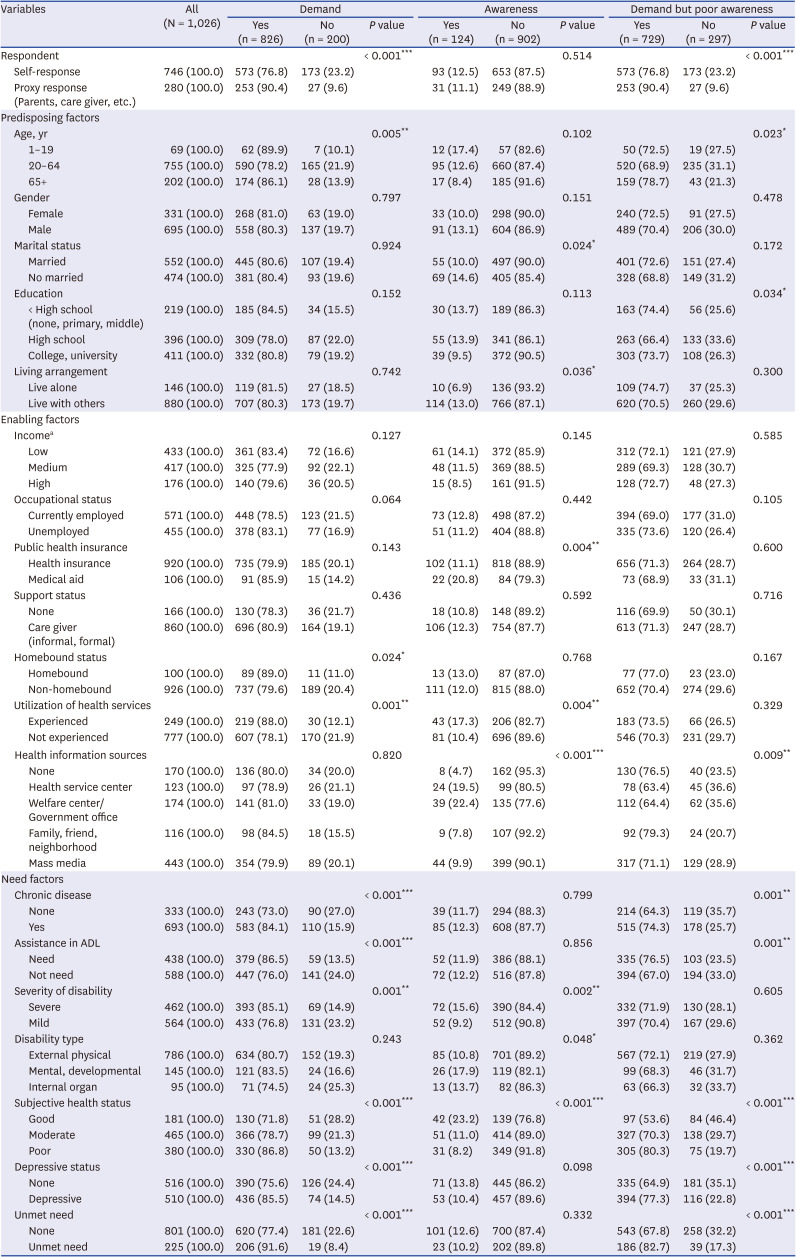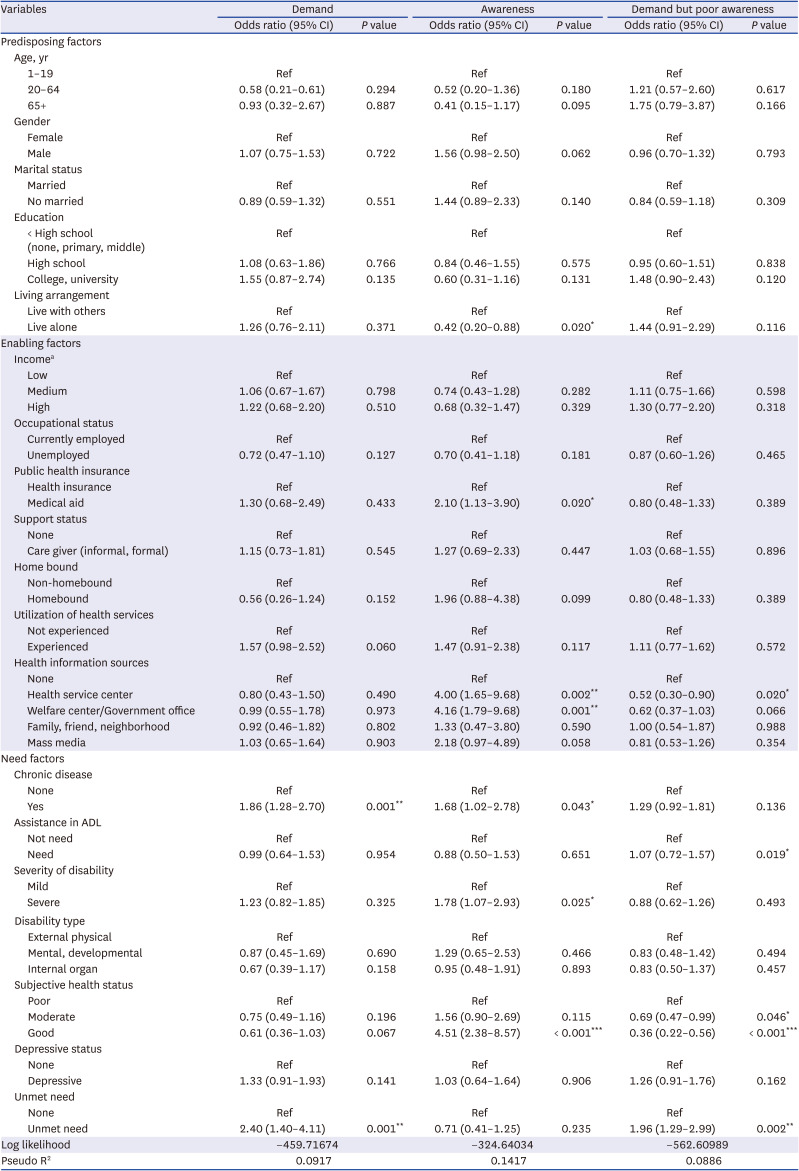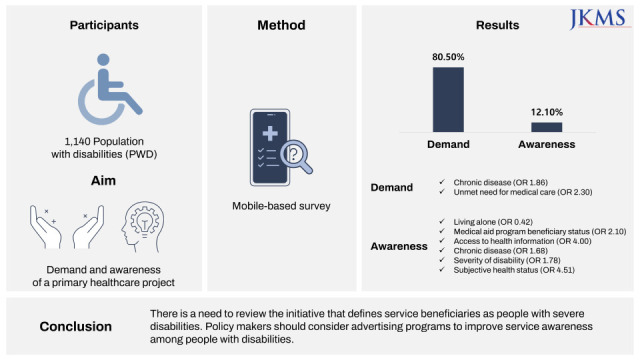1. Knowles E, O’Cathain A, Turner J, Nicholl J. Awareness and use of a new urgent care telephone service, NHS 111: cross-sectional population survey. J Health Serv Res Policy. 2014; 19(4):224–230. PMID:
24819379.

2. Al-rayes SA, Aldossary H, Aldoukhi E, Alahmedalyousif Z, Aldawood G, Alumran A. The awareness and utilization of 937-telephone health services in Saudi Arabia: cross-sectional survey study. Informatics in Medicine Unlocked. 2020; 20:100393.

3. Krout JA. Knowledge and use of services by the elderly: a critical review of the literature. Int J Aging Hum Dev. 1983; 17(2):153–167. PMID:
6671814.

4. Popplewell NT, Rechel BP, Abel GA. How do adults with physical disability experience primary care? A nationwide cross-sectional survey of access among patients in England. BMJ Open. 2014; 4(8):e004714.

5. Sakellariou D, Rotarou ES. Access to healthcare for men and women with disabilities in the UK: secondary analysis of cross-sectional data. BMJ Open. 2017; 7(8):e016614.

6. McColl MA, Jarzynowska A, Shortt S. Unmet health care needs of people with disabilities: population level evidence. Disabil Soc. 2010; 25(2):205–218.

7. Drainoni ML, Lee-Hood E, Tobias C, Bachman SS, Andrew J, Maisels L. Cross-disability experiences of barriers to health-care access: consumer perspectives. J Disabil Policy Stud. 2006; 17(2):101–115.
8. World Health Organization. WHO Global Disability Action Plan 2014–2021: Better Health for All People With Disability. Geneva, Switzerland: World Health Organization;2015.
9. Groenewegen PP, Kroneman M, Spreeuwenberg P. Physical accessibility of primary care facilities for people with disabilities: a cross-sectional survey in 31 countries. BMC Health Serv Res. 2021; 21(1):107. PMID:
33522925.

10. Sullivan WF, Diepstra H, Heng J, Ally S, Bradley E, Casson I, et al. Primary care of adults with intellectual and developmental disabilities: 2018 Canadian consensus guidelines. Can Fam Physician. 2018; 64(4):254–279. PMID:
29650602.
11. Shin DW, Choi YJ, Park JH, Park JH, Kim SY, Kim SH, et al. A Study on the Evaluating the Pilot Project for Primary Care for People With Disabilities. Wonju, Korea: Health Insurance Review & Assessment Service, the Ministry of Health and Welfare;2019.
12. Shin DS, Choi YJ. A pilot study of team-based primary health care for people with disabilities in South Korea. J Interprof Care. 2019; 33(1):129–132. PMID:
30321086.

13. Park JW. NARS Current Issues and Analysis. Current Status of Health Management Program for People with disabilities. Seoul, Korea: Korean National Assembly Research Service;2021.
14. Kim YJ, Shin SJ, Cho IY, Yoo JE, Park JH, Kang MW, et al. Disabled people’s experience and perception on the pilot project for primary care for people with disabilities. Korean J Fam Pract. 2021; 11(2):151–154.

15. Kim JA, Choi YJ, Heo MS, Oh CH, Choi KH. Team-based primary care program for disabled people and changes in rate of unmet health care needs. Fam Pract. 2021; 38(2):95–102. PMID:
32914841.

16. Kim MS, Choi KH, Kim JA, Park J, Jeong E. Analysis of related to unmet healthcare needs for the disabled in Korea using focus groups: focused on the 2nd Pilot project for primary care for people with disabilities. J Korea Converg Soc. 2021; 12:443–451.
17. Andersen RM. Revisiting the behavioral model and access to medical care: does it matter? J Health Soc Behav. 1995; 36(1):1–10. PMID:
7738325.

18. Kushman JE, Freeman BK. Service consciousness and service knowledge among older Americans. Int J Aging Hum Dev. 1986; 23(3):217–237. PMID:
3557638.

19. Calsyn RJ, Winter JR. Predicting older adults’ knowledge of services. J Soc Serv Res. 1999; 25(4):1–14.

20. Lee HJ, Lee TJ, Jeon BY, Jung YI. Factors related to health care utilization in the poor and the general populations. Korean Health Econ Rev. 2009; 15:79–106.
21. Shao S, Wang M, Jin G, Zhao Y, Lu X, Du J. Analysis of health service utilization of migrants in Beijing using Anderson health service utilization model. BMC Health Serv Res. 2018; 18(1):462. PMID:
29914464.

22. Kaya S, Sain Guven G, Aydan S, Toka O. Predictors of hospital readmissions in internal medicine patients: application of Andersen’s model. Int J Health Plann Manage. 2019; 34(1):370–383. PMID:
30221793.

23. Imbus JR, Voils CI, Funk LM. Bariatric surgery barriers: a review using Andersen’s model of health services use. Surg Obes Relat Dis. 2018; 14(3):404–412. PMID:
29249585.

24. Krout JA. Service awareness among the elderly. J Gerontol Soc Work. 1985; 9(1):7–19.

25. Fortin M, Bamvita JM, Fleury MJ. Patient satisfaction with mental health services based on Andersen’s behavioral model. Can J Psychiatry. 2018; 63(2):103–114. PMID:
29056085.

26. Song KS, Lee JH, Rhim KH. Factors associated with unmet needs for health care. Korean Public Health Res. 2011; 37(1):131–140.
27. Shin J. Determinants of unmet healthcare needs among the community-dwelling Korean adults with disabilities: a case of the national health insurance beneficiaries. Health Soc Welf Rev. 2013; 33(2):549–577.

28. Lee SE. Factors associated with awareness of services for dementia prevention among community-dwelling elderly. J Community Welf. 2015; 53(2):143–171.

29. Lee JS. The analysis of factors influencing on recognition of the disabled welfare service: focus on registration disable persons of Gwang-Ju city in South Korea. J Korean Soc Welf Adm. 2009; 11(2):75–102.
30. Hyun OS, Ma EG. A study on the recognition and satisfaction of welfare services for the elderly in Kyungnam island. Korean J Gerontol Soc Welf. 2010; 49(49):107–126.
31. Tindale J, Denton M, Ploeg J, Lillie J, Hutchison B, Brazil K, et al. Social determinants of older adults’ awareness of community support services in Hamilton, Ontario. Health Soc Care Community. 2011; 19(6):661–672. PMID:
21718377.

32. Chen CC, Lin YJ, Lin YT. Awareness and utilization of preventive care services among the elderly under National Health Insurance. Int J Health Care Finance Econ. 2013; 13(3-4):247–260. PMID:
23754318.

33. De-Rosende Celeiro I, Santos-Del-Riego S, Muñiz García J. Homebound status among middle-aged and older adults with disabilities in ADLs and its associations with clinical, functional, and environmental factors. Disabil Health J. 2017; 10(1):145–151. PMID:
27461941.

34. Negrón-Blanco L, de Pedro-Cuesta J, Almazán J, Rodríguez-Blázquez C, Franco E, Damián J, et al. Prevalence of and factors associated with homebound status among adults in urban and rural Spanish populations. BMC Public Health. 2016; 16(1):574. PMID:
27422021.

35. Bowerman BL, O’connell RT. Linear Statistical Models: An Applied Approach. Pacific Grove, CA, USA: Brooks/Cole;1990.
36. Myers RH, Myers RH. Classical and Modern Regression With Applications. Belmont, CA, USA: Duxbury Press;1990.
37. Menard S. Applied Logistic Regression Analysis. Thousand Oaks, CA, USA: SAGE Publications, Inc.;2002.
38. Kang P, Lee K, Kim C. Determinants of health service utilization of urban health center. Korean J Health Policy Adm. 1995; 5(2):104–126.
39. Santana IR, Mason A, Gutacker N, Kasteridis P, Santos R, Rice N. Need, demand, supply in health care: working definitions, and their implications for defining access. Health Econ Policy Law. 2021; 16:1–13. PMID:
32829722.
40. Verbrugge LM, Latham K, Clarke PJ. Aging with disability for midlife and older adults. Res Aging. 2017; 39(6):741–777. PMID:
28566012.

41. Pinto AD, Shenfeld E, Lattanzio R, Aratangy T, Wang R, Nisenbaum R, et al. Routine identification of patients with disabilities in primary care: a mixed-methods study. Disabil Health J. 2020; 13(2):100872. PMID:
31941610.

42. DeJong G. Primary care for persons with disabilities. An overview of the problem. Am J Phys Med Rehabil. 1997; 76(3 Suppl):S2–S8. PMID:
9210859.
43. Havercamp SM, Scandlin D, Roth M. Health disparities among adults with developmental disabilities, adults with other disabilities, and adults not reporting disability in North Carolina. Public Health Rep. 2004; 119(4):418–426. PMID:
15219799.

44. Drum CE, Krahn G, Culley C, Hammond L. Recognizing and responding to the health disparities of people with disabilities. Calif J Health Promot. 2005; 3(3):29–42.

45. Kinne S, Patrick DL, Doyle DL. Prevalence of secondary conditions among people with disabilities. Am J Public Health. 2004; 94(3):443–445. PMID:
14998811.

46. Kim JY, Kang MW, Seo WY, Lee JW. Chronic diseases, health behaviors, and mortality in persons with disabilities: an analysis of the National Health Insurance Service-Health Screening (NHIS-HEALS) database. Health Soc Welf Rev. 2020; 40:121–150.
47. Lee JH, Choi YJ, Volk RJ, Kim SY, Kim YS, Park HK, et al. Defining the concept of primary care in South Korea using a Delphi method. Fam Med. 2007; 39(6):425–431. PMID:
17549652.
48. Schottenfeld L, Petersen D, Peikes D, Ricciardi R, Burak H, McNellis R, et al. Creating Patient-Centered Team-Based Primary Care. Rockville, MD, USA: Agency for Healthcare Research and Quality;2016. p. 1–27.
49. Choi YJ, Ko BS, Cho KH, Lee JH. Concept, values, current status and prospect of primary care in Korea. J Korean Med Assoc. 2013; 56(10):856–865.

50. Yu DC. Health policy for people with disabilities in the United Kingdom. Glob Soc Secur Rev. 2018; (4):53–61.
51. Kim SH, Oh OC, Oh DE, Hwang JH, Oh MA, et al. Survey on Persons With Disabilities 2020. Sejong, Korea: Ministry of Health and Welfare;2020.
52. Jeon KH, Cho IY, Yoo JE, Park JH, Kang MW, Choi YJ, et al. Physicians’ experience from the pilot project for primary care for people with disabilities. Korean J Fam Pract. 2021; 11(2):147–150.

53. Levesque JF, Harris MF, Russell G. Patient-centred access to health care: conceptualising access at the interface of health systems and populations. Int J Equity Health. 2013; 12(1):18. PMID:
23496984.

54. Soltani S, Takian A, Akbari Sari A, Majdzadeh R, Kamali M. Financial barriers to access to health services for adult people with disability in Iran: the challenges for universal health coverage. Iran J Public Health. 2019; 48(3):508–515. PMID:
31223579.








 PDF
PDF Citation
Citation Print
Print




 XML Download
XML Download